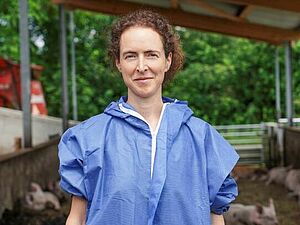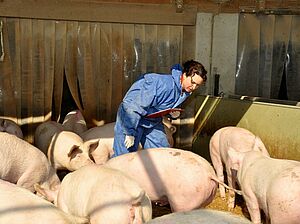"It is such a creative atmosphere"
50th anniversary voices


Mirjam Holinger has been at FiBL Switzerland, with interruptions, since 2008. Her career at FiBL started with an internship and a master's thesis. Today, she is the co-leader of the group Animal Housing & Livestock Breeding as well as one of the equal opportunity officers. The focus of her scientific work is animal welfare.
What brought you to FiBL?
In one of the first semesters of my bachelor's degree in agricultural sciences at ETH Zurich, we visited the animal hospital. There I saw a fistulated cow* for the first time. I couldn't really make sense of it myself. So, I started researching it and came across FiBL and Anet Spengler. I wrote her an e-mail in 2006 or 2007 and asked her what she thought about this fistulated cow, to which she sent me a long reply. She wrote how important this cow was for research and also for the treatment of other cows with rumen juice. At the same time, she acknowledged that this was quite an invasive procedure. I thought it was great that I received such a comprehensive and thoughtful response.
You came to FiBL as a trainee in 2008. What has changed since then?
Back then, everything was much smaller and everyone still knew everyone. I don't want to judge whether that was better or worse. It was simply different. The big growth in staff only occurred in the last three years. I was away from FiBL for a few years because of my doctorate at ETH Zurich and have been back here since 2019. The changes that have taken place since then are exciting. And there are still a lot of great people at FiBL.
Probably one of the reasons for coming back...
Yes, exactly. The people at FiBL have always been an important aspect for me. But it is more than that: It is such a creative atmosphere; I like that very much. You immediately get the impression that you can actively help shape something. You are allowed to think ahead and are rarely slowed down.
Today you are a research assistant in the field of pig husbandry. How did you get into pigs of all things?
That was mainly by chance. I came back to FiBL for my master's thesis, which took place within the framework of the "Feed no Food" project in the cattle sector. Pigs did not interest me at all at the time. However, after my master's thesis, a new project was launched on the subject of boar fattening, i.e. fattening pigs without castration. I joined this project and ended up staying with the pigs. I always thought that pigs don't get enough attention because you hardly ever see them. For me, everything has always been about animal welfare and good animal husbandry.
Do you think we are on the right track concerning organic pig farming in Switzerland?
In principle, Swiss pig farming is clearly better compared to much of the rest of Europe. This is mainly due to the stricter animal welfare regulations, such as mandatory anaesthesia for castration. There is also more space available. The question is always: what is the point of reference? Organic is comparable with other labels such as Coop Naturafarm or IP Suisse in terms of husbandry regulations. However, organic offers more: organic pigs also get organic feed and so on. Nevertheless, in the future we will have to deal with the question of how we can further develop husbandry and feeding.
A little over a year ago you became co-leader of the group Animal Housing & Livestock Breeding at FiBL together with Anet Spengler. What has been your experience with this new task?
I appreciate that I can do this together with Anet. At a retreat last year, we were able to establish that all group members have quite similar values with regard to animal husbandry. This is a valuable basis for cooperation.
You are also the equal opportunity officer at FiBL. How did this commitment come about?
When the directorate was re-staffed in 2020, I started to look more closely at this issue. For the first time, FiBL was led by three people, more specifically, three men. Many women at FiBL, including myself, were irritated. A certain diversity is important for good decisions. So, there is a gap, because there is a sufficiently high proportion of women in the study programme. I was interested in how this glass ceiling came about. Since then, we have been trying to raise awareness at FiBL on the issue of gender equality and, for example, to specifically promote young women so that they can later take on management tasks. And by now, one of the board of directors is a woman.
What are your wishes for FiBL for the future?
Above all, I would like FiBL to retain its drive and not become too constrained by bureaucracy, which can happen when an institution grows as strongly as we did. In my view, part of the success of FiBL is that many things here are uncomplicated and there are few unnecessary structures. It would be nice if FiBL continued to show the courage to do things differently. At FiBL, experiments – be they real or imaginary – can be made that would not be possible elsewhere. We must think ahead and continue to play a pioneering role in the future.
Interview: Ann Schärer
This is a shortened and slightly adapted version of an interview that appeared in the Bioaktuell magazine 3/23. Long versions of the interview in German, French and Italian are available online.
* During fistulation, a domestic cow is surgically given a screwable opening made of plastic as a connection between the rumen and the outside. This is used to examine the contents of the rumen or to remove or insert components. Above all, the examinations serve to study digestive processes. In addition, rumen juice can be taken directly through the fistula. On the one hand for laboratory examinations, on the other hand for therapeutic purposes for other cows with digestive problems. (Source: Wikipedia)
Further informationen
Download
- Interview "Es ist diese kreative Atmosphäre" published in Bioaktuell magazine 3/23 (in German) (217.3 KB)
- Interview "C’est cette atmosphère créative" published in Bioactualités magazine 3/23 (in French) (211.3 KB)
- Interview "È questa atmosfera creativa" published in Bioattualità magazine 3/23 (in Italian) (197.7 KB)



